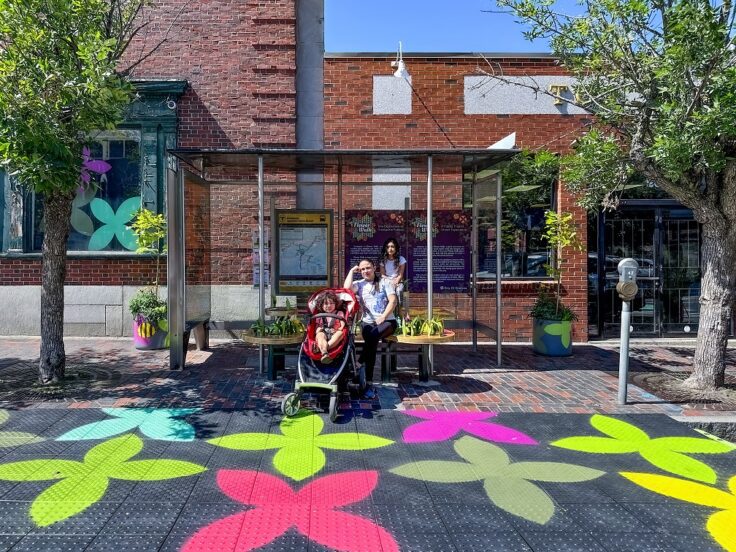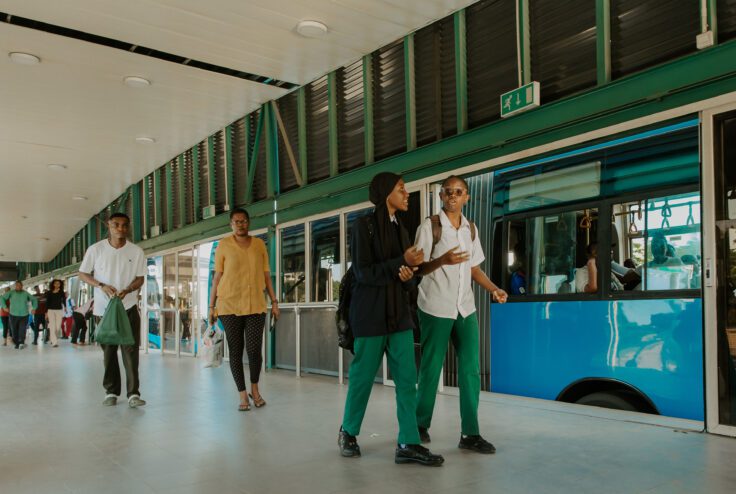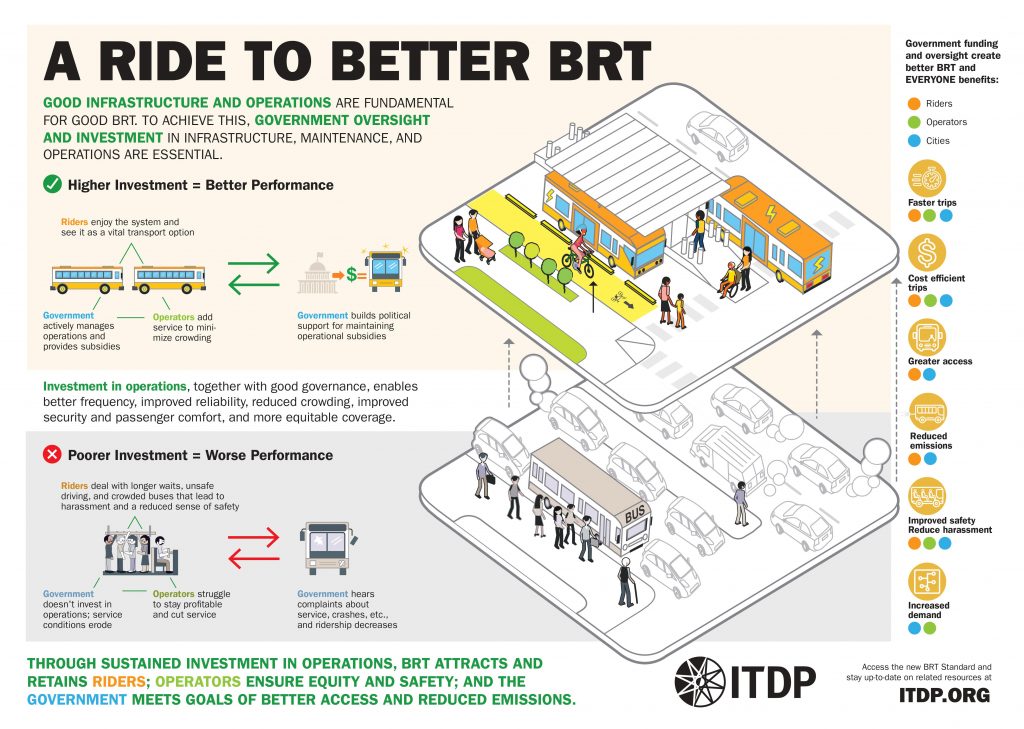In recent years, many cities have begun to invest more in improving the quality of public transport infrastructure, including both physical and operational innovations. However, compared to other transport investments (highways, airports, etc.), public transport receives far less support and is often considered secondary or less essential to many. Despite this, we know that public transport is vital to the functioning of all cities around the world, from Boston, USA to Nairobi, Kenya. And buses and minibuses are the backbone of public transport, serving the overwhelming majority of public transport trips. However, buses in particular are consistently underfunded and, consequently, under-appreciated in the broader transport agenda. At ITDP, we believe the bus needs to reclaim its place at the forefront of urban transport and progress.
Following the widespread impacts of the COVID-19 pandemic, which also served to highlight the essential nature of our public infrastructure, this is the time for cities to commit to improving public transport—starting with bus systems. Thus, ITDP is proud to debut the 2024 Edition of The Bus Rapid Transit (BRT) Standard, last updated in 2016, as part of our commitment to promoting quality BRT as a foundation for good public transport everywhere. The updates in this latest edition draw on ITDP’s decades of experience working on sustainable mobility and BRT projects worldwide, turning high-level policies and investments into on-the-ground transformation for all communities.
We know that now is the moment to be optimistic about our public transport systems, particularly ones that can be built around high-quality BRT and bus services. With the right investments, policies, and partnerships, this will be the year that buses help carry all cities into the future.

A vision for public transport
ITDP advocates for public transport systems with good service (that is, well-managed and well-funded) on clean vehicles, for everyone. In other words, a good public transport system is one in which people can use public transport to safely and reliably reach as many or more places as quickly as in a car or motorcycle. If the system is not getting people to destinations quickly, it is not serving the primary goal of transport. It is also critical to prioritize the needs of people who have been historically marginalized or who have the fewest mobility options, particularly women, children, people with low incomes, and people with disabilities.
Public transport — whether it is vans, buses, or trains — is essential to our urban environments because they can move many people in a small amount of space, so everyone can get where they are going. But all too often, people are face with the reality of slow buses, crowded and unreliable vans, gender-based harassment, and difficulties traveling with children or goods. Making public transport faster, more reliable, more secure, and more comfortable would help more people get to more places, and lead to less crowded streets and fewer high-emission vehicles on the roads.
We at ITDP and our partners are ultimately striving for public transport systems that are centered on the ideals of well-funded and well-managed service, clean vehicles, and accessibility for all.

This vision for public transport is essential to the health, safety, and livelihoods of the billions living in urban areas. As the world faces mounting environmental and economic crises, cities must have robust transport systems and dependable mobility services that protect and cater to all communities. We also know that one of the best forms of public transport infrastructure to address these challenges is BRT, which can be developed in a cost-effective, equitable, and climate-friendly manner in most global cities. In support of this overall vision, the 2024 BRT Standard builds on the years of best practices, knowledge sharing, and technical experience that ITDP has garnered since the Standard debuted in 2012.
The advancement and improvement of BRT systems in cities continues to be core to our sustainable transport goals, and this ‘year of the bus’ at ITDP is underscored by many of the forward-looking elements in the new Standard.
More than a decade since the Standard’s initial release, BRT is fortunately a much more familiar concept now to governments, decision-makers, communities, and everyday transit users. As a framework for understanding systems worldwide and evaluating them against best practices, the 2024 Edition provides critical insights into how and why BRT is the right tool for these times. Now, it is up to cities, policymakers, and funders to seize upon the economic, social, and environmental benefits of BRT to create more sustainable and equitable public transport for all.

BRT, for now and the future
Since its debut, the Standard has functioned as a common definition of BRT; a planning and evaluation tool; and a global recognition system for high-quality BRT systems. In addition, the Standard serves as a useful tool to evaluate critical components of any rapid public transport system. The 2024 Standard has been refreshed by adding, combining, and revising elements based on expert feedback and increasing deductions for operations.
The most significant changes include an expanded focus on gender, safety, and access; more attention to climate and electrification, as well as greening measures and resiliency; and a focus on user experience and operational improvements.
These changes not only reflect the necessities of a world transformed by climate change and a global pandemic, but also puts everyday transit users at the center of its guidance to ensure more inclusive access. In the years since the Standard first launched, over 153 corridors have opened in 91 cities across 24 countries, and interest in the impact and scalability of BRT continues to grow. By laying out the essential elements and criteria for BRT and rapid transport more broadly, the 2024 Standard provides a foundational framework for urban designers, decision-makers, and the sustainable transport community to truly understand and plan for high-quality public bus systems.
With the support and input of our Technical Committee composed of international transport and climate experts, the Standard ultimately serves as a framework for ensuring that more people have access to reliable mobility and more efficient and comfortable trips. Cities, meanwhile, will reap the benefits of an efficient, climate-friendly, and cost-effective rapid transport system that considers the realities of today while safeguarding urban mobility for the future.

Get on board!
To further promote the essential role of high-quality BRT and public buses in our cities, ITDP and our partners have developed an array of resources for the upcoming year that will provide more frameworks, technical guidance, and research into the pillars of operations and financing, clean and low-emission vehicles, equity and accessibility, and much more. In addition the 2024 Standard itself and our series of upcoming webinars, these resources include:
- Full translations of the Standard in ITDP’s key languages, including Spanish, Portuguese, Chinese, Bahasa Indonesia, and more;
- Infographics outlining the important elements of BRT;
- The release of a Simplified Calculator of Project Emissions (SCOPE) tool and technical guidance to help planners and policymakers calculate the climate impacts of BRT corridors;
- A report on The Future of Public Transport with concepts drawn from the MOBILIZE Learning Lab program in 2023;
- Additional briefs and research on bus electrification, public transport funding and financing, and good service;
- An ITDP Learning Hub Course on BRT Planning; and
- More in-depth blog pieces that will dive into all ‘Year of the Bus’ themes.
Help ITDP promote #ITDPYearoftheBus, the 2024 Standard, and all of our resources throughout the year!
Be sure to follow and subscribe to ITDP on X (Twitter), Linkedin, YouTube, and our Sustainable Transport Bulletin for more updates.
With a growing acknowledgement amongst decision-makers of the scalable impact of BRT systems, this is the year we call on all transport stakeholders — from elected officials to everyday users — to join us in advocating for high-quality bus services that meet the needs of everyone.
